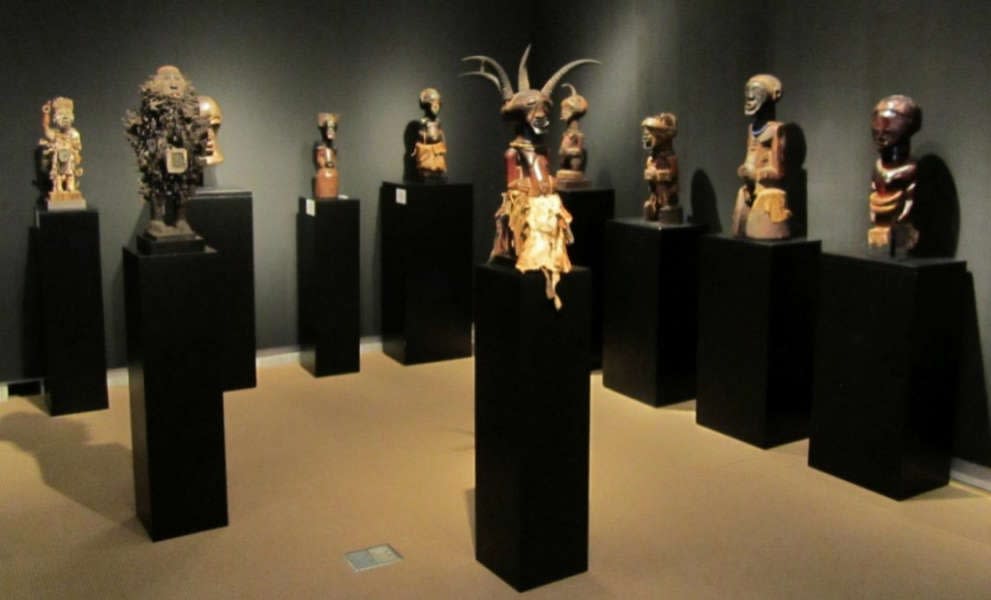
The first part of Sotheby’s sale of the Allan Stone Collection of African, Oceanic, and Indonesian Art was a big succes to say the least. The auction lasted more than 4 hours (for 154 lots), with the auctioneer taking his time to extract each and every single dollar in the room, on the phone or online. Some statistics (including the Oceanic and Indonesian Art) explain why Heinrich Schweizer & co. can be very happy.
The sale total was $ 11,5 million (including buyer’s premium) against a high estimate of $ 8,8 million, thus exceeding the high estimate by more than 30,6%. The sale was sold 94% by lot and 97% by value. Seen the very personal character of the collection, I think this is very praiseworthy. Clearly this was not a collection made by a classic African art collector, but an assembly of dramatic objects, strong in effect, which fitted the very personal taste of Allan Stone. The documentary about his life made it clear what a truly remarkable character he was. Eclectic in his taste, African art was just one of his many passions. Nevertheless, due to his good contacts with important dealers such as Merton Simpson, Michael Oliver and Maureen Zarember, Stone was able to acquire many important pieces.
Two objects in the sale sold above the one million dollar mark: the ex Josef Müller Kongo figure for $ 1,805,000 (est. $ 400K-600K) (Mr. Barbier-Müller will probably not be amused) and the cover lot, the four-horned Songye figure which sold for $ 2,165,000 ($ 600K-900K), living up to the expectations Sotheby’s had for it. The high hopes for two other pieces failed to realize; the proto Dogon figure (est. $ 400K-600K), sold for only $ 425K and the rare Kuba headdress (est. $ 600K-900K), which was hammered down below the lowest estimate at $ 581K – nevertheless still an incredible price for a Kuba mask.
100 of the 154 lots sold above the high estimate. That’s 65 % of the sale ! Many of the “smaller” objects were very reasonably priced, which generated of course some extra attention. A smart move of Sotheby’s, not hindered by any restrictions of the Stone estate. Good examples of this strategy were the Tellem figure (est. $ 2K-3K), selling for $ 14,375; the Kongo miniature figure (est. $ 2,5K-3,5K), which sold for $ 7,5K or the Kongo figure fragment (est. $ 15K-25K) selling for $ 81,250.
All my personal favourites did very well. The incredible Lagoon figure (est. $ 120K-180K), easily doubling its estimate to $ 269K. The fantastic Wobe mask (est. $ 7K-10K) with bulging eyes, which sold for $ 32,5K to a French dealer who also had noticed its exceptional quality. The small cubistic Luba figure (est. $ 3K-5K), selling for $ 12,5K and the rare Makonde helmet mask representing a sikh (est. $ 15K-25K), which sold for $ 21,250. For me, the absolute winner of the sale was the Kongo figure (est. $ 150K-250K) called Chingunge’N. Collected in situ by Robert Visser before 1903, this figure presented a once in a decade oppurtunity to acquire an exceptionally well documented Kongo figure. At $ 293,000 still a very good deal in my opinion. A revelation for me, was the Dayak fragment, illustrated below – in real life an extremely powerful sculpture.
Only 20 lots (or 13 %) sold within the estimate range and 24 lots (16 %) sold under the low estimate. For the connoisseur some real bargains could be made. What to think of the Wurkun shoulder mask (est. $ 7K-10K), which sold for a mere $ 4,375. Though it was not in a very good condition, that’s no money for such an old and big piece. Another smart buy was the rare Ejagham janus headdress (est. $ 8K-12K), which sold for $ 5,250. The reserve price always being a little more than half the low estimate, there were definitely some opportunities for the attentive bidder.
Only 9 from the 154 lots (or 6 %) failed to sell (all African by the way); the most important being the Songye kifwebe mask in the “Mussolini”-style (est. $ 300-500K). Its association with Picasso’s Les Demoisselles d’Avignon in the catalogue of course didn’t made much sense seen the fact the Picasso only could have seen a kifwebe mask much later.
One object was removed from the sale, lot 75, the Igbo maiden spirit mask (possibly a forgery by Odo of Imelike or his workshop).
While pre-sale some dealers doubted the favorable outcome of this sale, Sotheby’s once again proved its possibility to successfully place a collection in the market. Being either for or against their recontextualisation of the once very private Stone collection, everybody has to admit that they succeeded in making Allan Stone known as a collector of African art. This sale confirmed the solid state of the African art market. Selling one big Songye figure after the other, most above the high estimate, this auction will also be remembered as an important momentum in the appreciation of Songye sculpture.
